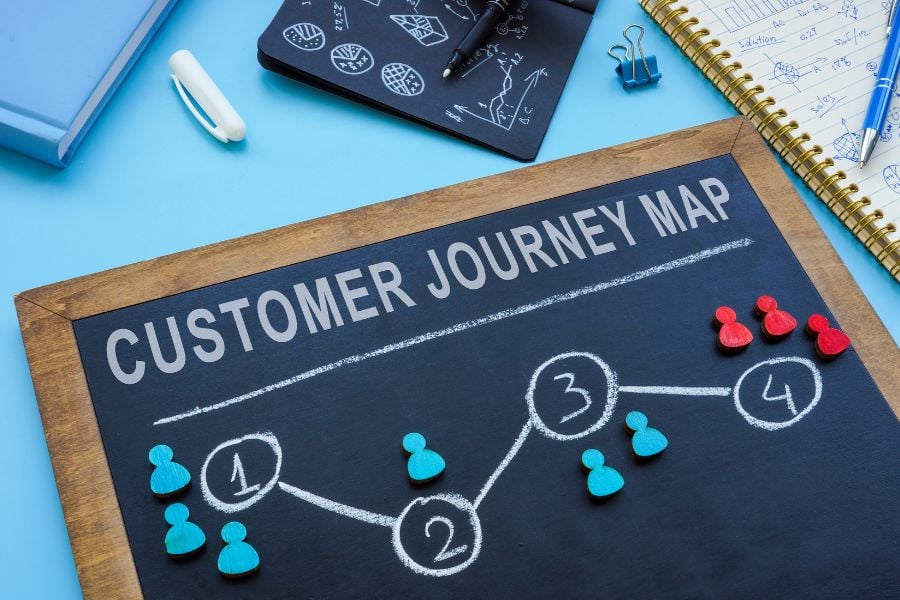In today’s marketplace, mastering your customer journey map is no longer optional — it’s essential to your success.
Why?
Because it’s your secret weapon for driving (and repeating) serious sales.
With an accurate roadmap, you will be able to consistently and reliably achieve your goals and drive customer engagement, conversion, and loyalty.
This guide will offer actionable techniques to design a customer journey map that works and maximizes your marketing results.
Ready to transform your customer journey and boost those sales?
Let’s dive right in.

What is a Customer Journey Map? (& Why You Need One)
Customer journey maps are not just another fancy business term; it’s a powerful strategic tool that can transform your business if you do it right.
At its core, customer journey maps are a visual representation of your customer’s experience with your business, from the initial point of contact through various stages of engagement, right up to the final interaction and even beyond.
It maps out the entire path, highlighting customer needs, motivations, emotions, and pain points at each step of the way.
Think of it as a storyboard that captures the entire customer narrative.
Imagine being able to step into your customer’s shoes, see your business through their eyes, and understand their every step, thought, and feeling as they interact with your brand.
This is what a customer journey map offers — a deep, insightful peek into your customer’s world.
But why should this matter to you?
In today’s competitive business landscape, providing top-notch customer experience is not just a nice-to-have; it’s a must-have.
And that’s where a customer journey map becomes indispensable.
By understanding your customer’s journey, you can pinpoint where they struggle, what delights them, and what keeps them coming back. You can identify gaps in your services and opportunities for improvement.
More importantly, you can design experiences that are not just satisfying but also memorable, fostering stronger connections with your customers.
But remember, a customer journey map is not a set-it-and-forget-it tool.
It’s dynamic, evolving with your customer needs and expectations change. It’s a continuous process of learning, iterating, and improving — a compass that guides your strategies, decisions, and actions.
So, if you want to keep your customers happy, your business thriving, and stay ahead of the competition, then a customer journey map is an invaluable asset you simply can’t ignore.
Let’s dive deeper and see how you can harness its power.
The 4 Key Stages of the Customer Journey

In every person’s path from stranger to customer, the journey can generally be distilled into four fundamental stages:
Awareness, Consideration, Decision, and Retention.
Each customer journey stage represents a critical customer touchpoint that can make or break the customer’s relationship with your brand.
And understanding these stages so that you can tailor your strategies to keep your potential customer on the path to conversion is key to crafting an effective customer journey map.
Stage 1: Awareness
In this first customer journey stage, the customer learns about your brand or product, often because they have a problem they need to solve or a desire they want to fulfill.
The customer touchpoint at this stage sets the tone for the entire relationship, so you need to make it count.
To seize this moment, ensure your brand is visible in the right places and communicates a compelling value proposition that resonates with the customer’s needs or desires.
An awareness stage example?
Think of targeted online ads or impactful SEO strategies that get your brand in front of those who need it most.
Stage 2: Consideration
Here, the potential customer weighs their options.
They’re asking: “Does this brand’s product or service meet my needs? Is it worth the investment?”
This is a time for education and persuasion. Make use of detailed product descriptions, persuasive testimonials, and comprehensive comparison charts.
Provide valuable, easy-to-digest content that helps the customer see the tangible benefits of choosing your brand over the competition.
Stage 3: Decision
The third stage is the tipping point, when the customer decides to make a purchase, or not.
This stage is all about facilitating a smooth, frictionless buying process.
A complex checkout procedure or hidden costs can result in shopping cart abandonment.
So keep things transparent and user-friendly. An important tip here is to offer various payment options and ensure your site’s loading speed is optimized for a seamless checkout process.
Stage 4: Retention
Once the transaction is complete, it’s onto customer retention. The focus shifts to nurturing a long-term relationship with the customer, encouraging repeat purchases, and fostering brand loyalty.
Post-purchase service, follow-up emails, customer loyalty programs, and customer feedback surveys are all customer journey mapping tools you can use to ensure customers stay connected to your brand.
A powerful example is Amazon’s Prime membership, offering benefits that go beyond the initial purchase, ensuring customers stick around for more.
Crafting a Solid Customer Journey Map in 6 Basic Steps

Okay, so now that you’re familiar with the 4 phases of the customer journey, how do you practically use that to create your own map?
Step 1. Define Your Ideal Buyer Persona
Creating a customer journey map begins with understanding who your customer is.
This step involves defining your buyer (or customer) persona — a semi-fictional representation of your ideal customer.
Developing a comprehensive customer persona involves more than just demographic information. It includes understanding existing customer behavior, motivations, preferences, and needs.
For example, if you’re a tech startup offering a digital note-taking solution, your customer persona could be “busy college students,” who are characterized by a need for quick, efficient note organization, a preference for mobile solutions, and multitasking behavior.
Remember, the more detailed your buyer persona, the more targeted your map will be.
Step 2. Understand Touchpoints
Next, identify the different points of interaction between the customer and your business.
These touchpoints can range from seeing an advertisement, visiting a website or even a physical store, speaking to a salesperson, interacting with your brand on social media, or using the product.
Knowing where these touchpoints are is crucial to understanding your customer’s journey and ensuring the user experience at each point is positive.
And remember to consider both online and offline touchpoints to get a full picture of the customer’s journey.
For instance, “busy college students” may first encounter your product through social media ads, then visit your website or app store to download, and finally interact with customer support for queries.
At each of these stages, you want to make sure the user experience is positive enough that they want to keep interacting with you and your brand.
Step 3. Conduct In-Depth Research
Customer journey mapping isn’t just about assumptions — it’s grounded in research.
This could involve surveys, interviews, or even analyzing customer data. Use these insights to refine your map and make it more accurate.
Keep in mind the goal is to identify not just what customers are doing, but why they are doing it.
Consider asking questions like “Why did you choose our product?” or “What challenges did you face while using our product?”
The insights from this research can help you further refine your customer personas and their journey maps.
And remember that both solicited data (from surveys, for instance) and unsolicited data (from customer feedback or reviews) can enrich your customer journey map.
The goal is to uncover key insights about your customer behavior, needs, and preferences.
Step 4. Troubleshoot Your Customer’s Journey

No journey is without its bumps. In customer journey mapping, these bumps are friction points — areas where the customer’s experience is less than satisfactory.
With your customer personas and touchpoints defined, and ample research conducted, you should now have a solid understanding of your customer’s journey.
Now it’s time to troubleshoot: identify any roadblocks or friction points in the journey that could be hindering a smooth customer experience.
Using the example above, perhaps “Busy College Students” are having trouble syncing their notes across multiple devices, creating frustration and potentially leading them to seek other solutions.
Identifying these points helps you improve your service and ensure a smoother journey for your customers.
Step 5. Streamline and Perfect Your Customer’s Journey
Once you’ve identified problem areas, work to resolve them and create a seamless customer journey.
This could involve redesigning a part of your website for better usability, improving the onboarding process of your product, or providing more personalized customer service.
For instance, to solve the syncing issue for “busy college students”, you could develop a simpler, more efficient syncing process and offer a step-by-step guide to help them navigate it.
Devising solutions to any issues that arise and streamlining your processes for a seamless customer experience will make sure your customers stick around!
Step 6. Keep Your Map Fresh and Relevant
The customer journey isn’t static; it evolves as customers’ needs and preferences change, and as your business grows.
That’s why it’s important to regularly revisit and update your customer journey map to ensure that it continues to accurately reflect your customers’ experiences.
This will aid in identifying new opportunities or issues.
Keep an eye on your key performance indicators (KPIs).
These metrics can include customer satisfaction scores, net promoter scores, churn rates, and customer lifetime value, among others.
Watching these metrics can help you understand the effectiveness of your customer journey map and where adjustments may be needed.
Unleashing Your Potential with the Customer Journey Map
You made it! You’ve journeyed together through the intricacies of the customer journey map, explored actionable strategies, practical examples, and even addressed some common pitfalls.
Now, it’s your turn to take the reins.
Remember, the customer journey map isn’t just a tool; it’s your lifeline to understanding, connecting with, and transforming your customers into loyal advocates.
So, what are you waiting for?
Roll up your sleeves and start mapping your path to unprecedented success!



